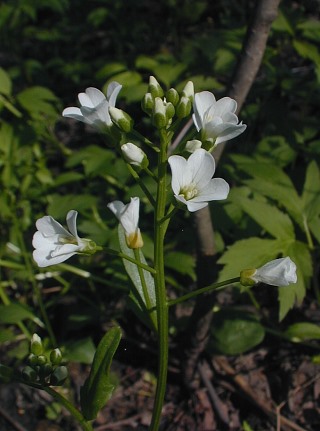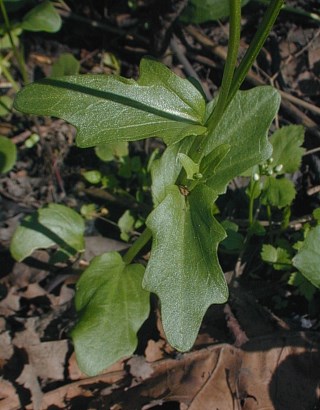Description:
This
perennial wildflower is ½–1½' tall with an erect stem that is
unbranched or sparingly branched toward the apex where the
inflorescence occurs. The central stem is medium green, glabrous, and
terete; it occasionally has fine longitudinal ridges. There are both
basal leaves and alternate leaves. The blades of the basal leaves are
up to 1¼" long and 1" across; they are oval to orbicular in shape, medium green, glabrous, and
smooth or undulate along their margins. The slender petioles of the
basal leaves are usually longer than the blades. The alternate leaves
are produced sparingly along the central stem; they are up to 2" long
and 1" across, medium green, and glabrous. The alternate leaves are
oblong-ovate in shape and their margins are smooth, undulate, or
bluntly dentate; at the base, each alternate leaf is sessile or
short-petioled. The central stem terminates in a raceme of flowers; the
flowers usually bloom in the upper half of the raceme, while their
siliques (narrowly cylindrical seedpods) develop below. Each flower
consists of 4 petals, 4 sepals, 6 stamens, and a pistil with a single
style; when the flower is fully open, it spans about ½" across. The
petals are white with rounded tips. The glabrous sepals are initially
green, but they become yellow as they age. The petals are much longer
than the sepals. Each flower has a slender pedicel about ½" long. The
blooming period occurs from mid- to late spring and lasts about 3
weeks. The flowers are sometimes fragrant. Each flower is replaced by a
slender hairless silique about 1" long that is somewhat flattened. The
siliques are ascending to erect; they eventually divide into two parts
to release their seeds. These seeds are ovoid, somewhat flattened, and
wingless; they are arranged in a single row in each silique. Each plant
has a swollen tuberous rootstock at the base of the central stem; this
tuberous rootstock has spreading fibrous roots that occasionally
produce small tubers. New plants are created from either the seeds or
tubers.
medium green, glabrous, and
smooth or undulate along their margins. The slender petioles of the
basal leaves are usually longer than the blades. The alternate leaves
are produced sparingly along the central stem; they are up to 2" long
and 1" across, medium green, and glabrous. The alternate leaves are
oblong-ovate in shape and their margins are smooth, undulate, or
bluntly dentate; at the base, each alternate leaf is sessile or
short-petioled. The central stem terminates in a raceme of flowers; the
flowers usually bloom in the upper half of the raceme, while their
siliques (narrowly cylindrical seedpods) develop below. Each flower
consists of 4 petals, 4 sepals, 6 stamens, and a pistil with a single
style; when the flower is fully open, it spans about ½" across. The
petals are white with rounded tips. The glabrous sepals are initially
green, but they become yellow as they age. The petals are much longer
than the sepals. Each flower has a slender pedicel about ½" long. The
blooming period occurs from mid- to late spring and lasts about 3
weeks. The flowers are sometimes fragrant. Each flower is replaced by a
slender hairless silique about 1" long that is somewhat flattened. The
siliques are ascending to erect; they eventually divide into two parts
to release their seeds. These seeds are ovoid, somewhat flattened, and
wingless; they are arranged in a single row in each silique. Each plant
has a swollen tuberous rootstock at the base of the central stem; this
tuberous rootstock has spreading fibrous roots that occasionally
produce small tubers. New plants are created from either the seeds or
tubers.
Cultivation:
The preference is partial sun or dappled sunlight, wet to moist
conditions, and a loose fertile loam with organic material. Shallow
standing water is tolerated if it is temporary; full sun is tolerated
if the ground is consistently moist. Most growth and development occurs
during the spring before the canopy trees leaf out.
Range & Habitat:
The native Spring Cress is occasional to locally common in most areas
of Illinois;
it is less common or absent in the SW section of the state (see Distribution
Map). This species may be less common than in the past.
Habitats include low woodlands along rivers, edges of vernal pools in
woodlands, damp depressions in rocky bluffs, woodland seeps and
springs, and damp meadows.

Faunal Associations:
The nectar of the flowers attracts cuckoo bees (Nomada spp.),
mason bees (Osmia spp.), little carpenter bees (Ceratina
spp.), Halictid bees (Augochlorella spp., Halictus
spp., & Lasioglossum spp.),
Andrenid bees (Andrena spp.), bee flies (Bombylius
spp.), dance flies (Empis spp.), Syrphid
flies (miscellaneous), small- to medium-sized butterflies
(miscellaneous), and skippers (miscellaneous). Some of the bees also
collect pollen. The flea beetles Phyllotreta oblonga
and Phyllotreta bipustulata feed on Spring Cress
and other Cardamine spp. (Bitter Cress species).
Mammalian herbivores usually avoid the consumption of Spring Cress
because its foliage is pungent and somewhat bitter.
Photographic Location:
A low woodland along the Sangamon river in Piatt County, Illinois.
Comments:
Spring Cress is one of the more attractive members of the Mustard
family as its flowers are fairly large (spanning about ½" across). This
wildflower favors the more damp areas of woodlands and it is sometimes
found in soggy meadows. Another native species, Cardamine
douglassii (Purple Cress), is very similar to Spring Cress.
Both species prefer similar habitats, bloom during the spring, and
their flowers and foliage are similar to each other. Purple Cress
differs from Spring Cress by the purplish-pink tint of its flower
petals, sepals that are dark purple and hairy, and stems that are hairy
toward the base. It has a tendency to bloom about 2 weeks before Spring
Cress. Other Cardamine spp. (Bitter Cress species)
in Illinois have either smaller flowers (about ¼" across or less) or at
least some of their leaves are deeply divided into lobes (either
pinnately or palmately). Spring Cress (and other species in the genus)
isn't classified as an Arabis sp. (Rock Cress)
because of its wingless seeds; the seeds of Rock Cresses have winged
membranous margins of varying widths.